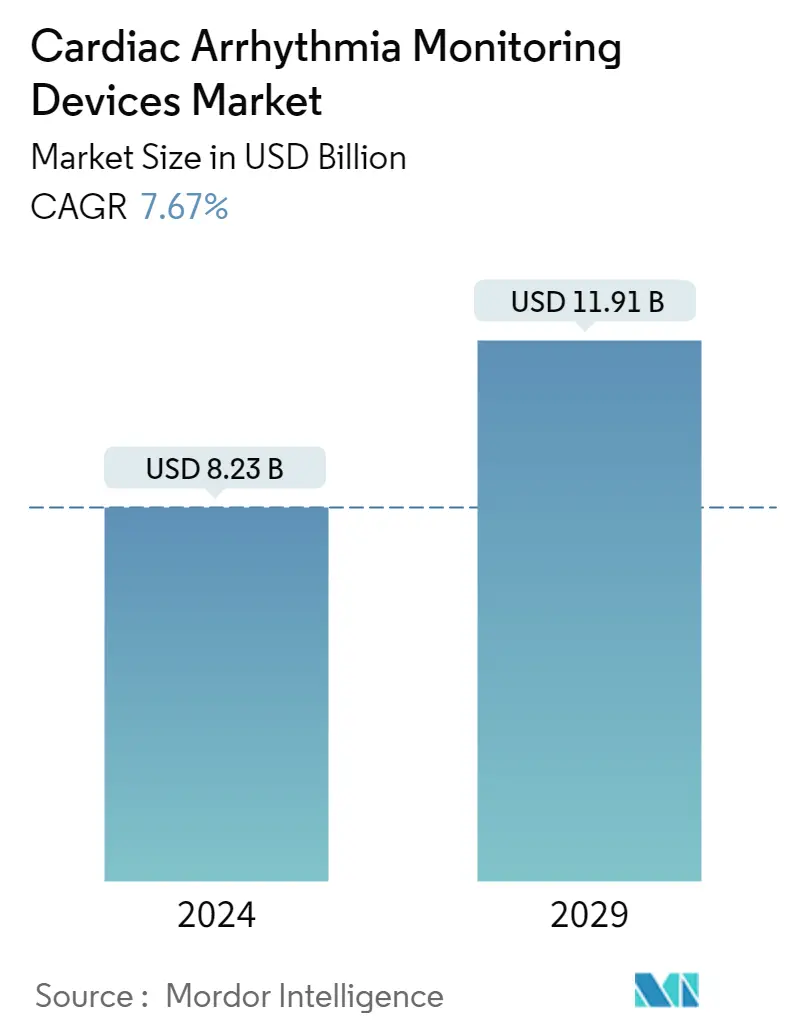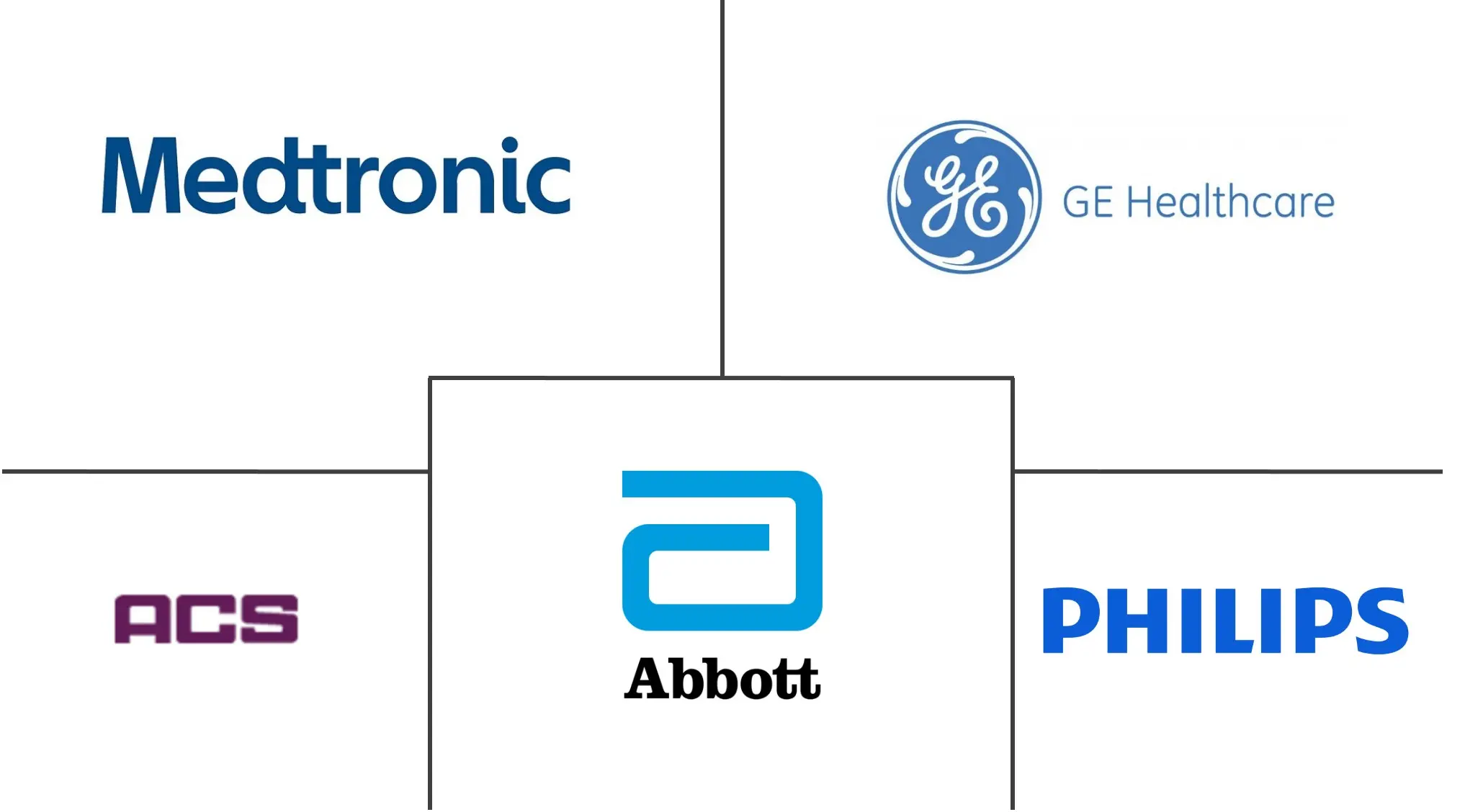Market Size of Cardiac Arrhythmia Monitoring Devices Industry

| Study Period | 2019 - 2029 |
| Market Size (2024) | USD 8.23 Billion |
| Market Size (2029) | USD 11.91 Billion |
| CAGR (2024 - 2029) | 7.67 % |
| Fastest Growing Market | Asia Pacific |
| Largest Market | North America |
Major Players
*Disclaimer: Major Players sorted in no particular order |
Cardiac Arrhythmia Monitoring Devices Market Analysis
The Cardiac Arrhythmia Monitoring Devices Market size is estimated at USD 8.23 billion in 2024, and is expected to reach USD 11.91 billion by 2029, growing at a CAGR of 7.67% during the forecast period (2024-2029).
The COVID-19 pandemic has significantly impacted the cardiac arrhythmia monitoring market as several inpatient and outpatient cardiac procedures were postponed or delayed. As a result, the diagnosis of patients suffering from arrhythmias was substantially reduced. However, due to the emerging cardiac complications associated with COVID-19, the demand for arrhythmia monitoring devices is set to increase in the future. For instance, as per a July 2020 published article titled "COVID-19 and cardiovascular disease: from basic mechanisms to clinical perspectives", COVID-19 patients with underlying cardiovascular comorbidities have high mortality. The same source also reported that arrhythmias and sudden cardiac arrest are common manifestations of COVID-19. As per a December 2020 published article titled "Incidence rate and clinical impacts of arrhythmia following COVID-19: a systematic review and meta-analysis of 17,435 patients", arrhythmia is a potential cardiovascular complication of COVID-19. As per the study, in one case series of patients hospitalized with COVID-19, 16.7% developed unspecified arrhythmia. Thus, the demand for cardiac arrhythmia monitoring devices is anticipated to increase over the coming years.
Further, the market's growth can be largely attributed to the increasing use of telecardiology, ease of use and portability of cardiac arrhythmia monitoring devices, and the development of smart cardiac monitors.
Increasing usage of telecardiology is a major factor driving the market's growth. Telecardiology, in general, provides a monitoring device that can be fixed on the chest area of patients suffering from cardiac arrhythmia. Telecardiology is a cost-effective intervention for the elderly population affected by heart failure. Thus, the adoption of telecardiology is increasing. Several companies are launching their telecardiology services, propelling the market's growth. For instance, in December 2020, Coala Life launched a direct-to-patient telecardiology service. The product is a patch-free, smartphone-powered electrocardiogram (ECG) monitor that provides diagnostic quality and real-time detection of the most common cardiac arrhythmias.
The ease of use and portability of cardiac arrhythmia monitoring devices is one of the major factors driving the market's growth. For instance, in February 2021, RhythMedix launched its next-generation wearable novel cardiac telemetry monitor with built-in 4G cellular connectivity for arrhythmia detection. Thus, such developments may fuel the development of more types of similar cardiac monitors that are easy to carry and portable, thereby fueling the market's growth.
Nonetheless, poor adoption of telemetry technology in emerging markets and the high cost of remote cardiac arrhythmia monitoring devices are hindering the market's growth.
Cardiac Arrhythmia Monitoring Devices Industry Segmentation
As per the scope of the report, cardiac arrhythmia monitoring devices are used for monitoring patients at risk or with heart arrhythmia. These devices detect and alarm irregular heartbeats that are either too slow or too fast. The market is segmented by devices, service providers, and geography. The market report also covers the estimated market sizes and trends for 17 countries across major regions globally. The report offers the value in USD million for the above segments.
| By Devices | |
| Event Monitoring Devices | |
| Continuous Rhythm Monitoring Devices | |
| Holter Monitoring Devices | |
| Other Devices |
| By Service Providers | |
| Mobile Cardiac Telemetry Monitoring Service Providers | |
| Independent Diagnostic Testing Facilities/Clinics |
| By Geography | ||||||||
| ||||||||
| ||||||||
| ||||||||
| ||||||||
|
Cardiac Arrhythmia Monitoring Devices Market Size Summary
The cardiac arrhythmia monitoring devices market is poised for significant growth, driven by the increasing prevalence of arrhythmias and advancements in monitoring technology. The market is experiencing a resurgence in demand due to the complications arising from COVID-19, which have highlighted the need for effective monitoring solutions. The rise of telecardiology, characterized by its cost-effectiveness and ease of use, is a major factor propelling market expansion. Companies are introducing innovative products, such as smartphone-powered ECG monitors and wearable telemetry devices, which enhance patient compliance and treatment outcomes. Despite challenges like high costs and limited adoption in emerging markets, the market is expected to grow steadily, with Holter monitoring devices leading the way due to their ability to provide long-term and convenient monitoring.
In North America, particularly the United States, the market is witnessing robust growth due to the adoption of advanced cardiovascular solutions and a sophisticated healthcare infrastructure. The increasing incidence of atrial fibrillation and other arrhythmias is driving demand for monitoring devices. Regulatory approvals for new products, such as the Biotres Cardiac Monitoring Device, are further supporting market expansion. The competitive landscape is marked by strategic activities like mergers, acquisitions, and partnerships among key players such as Abbott, GE Healthcare, and Medtronic PLC. These companies are focusing on enhancing their product offerings and expanding their market presence through innovative technologies and geographical expansion.
Cardiac Arrhythmia Monitoring Devices Market Size - Table of Contents
-
1. MARKET DYNAMICS
-
1.1 Market Overview
-
1.2 Market Drivers
-
1.2.1 Increasing Use of Telecardiology
-
1.2.2 Ease of Use and Portability of Cardiac Arrhythmia Monitoring Devices
-
1.2.3 Development of Smart Cardiac Monitors
-
-
1.3 Market Restraints
-
1.3.1 Poor Adoption of Telemetry Technology in Emerging Markets
-
1.3.2 High Cost of Remote Cardiac Arrhythmia Monitoring
-
-
1.4 Porter's Five Forces Analysis
-
1.4.1 Threat of New Entrants
-
1.4.2 Bargaining Power of Buyers/Consumers
-
1.4.3 Bargaining Power of Suppliers
-
1.4.4 Threat of Substitute Products
-
1.4.5 Intensity of Competitive Rivalry
-
-
-
2. MARKET SEGMENTATION (Market Size by Value - USD million)
-
2.1 By Devices
-
2.1.1 Event Monitoring Devices
-
2.1.2 Continuous Rhythm Monitoring Devices
-
2.1.3 Holter Monitoring Devices
-
2.1.4 Other Devices
-
-
2.2 By Service Providers
-
2.2.1 Mobile Cardiac Telemetry Monitoring Service Providers
-
2.2.2 Independent Diagnostic Testing Facilities/Clinics
-
-
2.3 By Geography
-
2.3.1 North America
-
2.3.1.1 United States
-
2.3.1.2 Canada
-
2.3.1.3 Mexico
-
-
2.3.2 Europe
-
2.3.2.1 Germany
-
2.3.2.2 United Kingdom
-
2.3.2.3 France
-
2.3.2.4 Italy
-
2.3.2.5 Spain
-
2.3.2.6 Rest of Europe
-
-
2.3.3 Asia-Pacific
-
2.3.3.1 China
-
2.3.3.2 Japan
-
2.3.3.3 India
-
2.3.3.4 Australia
-
2.3.3.5 South Korea
-
2.3.3.6 Rest of Asia-Pacific
-
-
2.3.4 Middle-East and Africa
-
2.3.4.1 GCC
-
2.3.4.2 South Africa
-
2.3.4.3 Rest of Middle-East and Africa
-
-
2.3.5 South America
-
2.3.5.1 Brazil
-
2.3.5.2 Argentina
-
2.3.5.3 Rest of South America
-
-
-
Cardiac Arrhythmia Monitoring Devices Market Size FAQs
How big is the Cardiac Arrhythmia Monitoring Devices Market?
The Cardiac Arrhythmia Monitoring Devices Market size is expected to reach USD 8.23 billion in 2024 and grow at a CAGR of 7.67% to reach USD 11.91 billion by 2029.
What is the current Cardiac Arrhythmia Monitoring Devices Market size?
In 2024, the Cardiac Arrhythmia Monitoring Devices Market size is expected to reach USD 8.23 billion.

